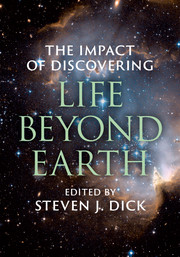Book contents
- Frontmatter
- Dedication
- Contents
- List of contributors
- Introduction: Astrobiology and society
- Part I Motivations and approaches: How do we frame the problems of discovery and impact?
- 1 Current approaches to finding life beyond Earth, and what happens if we do
- 2 The philosophy of astrobiology: The Copernican and Darwinian philosophical presuppositions
- 3 History, discovery, analogy: Three approaches to the impact of discovering life beyond Earth
- 4 A multidimensional impact model for the discovery of extraterrestrial life
- Part II Transcending anthropocentrism: How do we move beyond our own preconceptions of life, intelligence, and culture?
- Part III Philosophical, theological, and moral impact: How do we comprehend the cultural challenges raised by discovery?
- Part IV Practical considerations: how should society prepare for discovery – and non-discovery?
- Contributor biographies
- Index
- References
1 - Current approaches to finding life beyond Earth, and what happens if we do
from Part I - Motivations and approaches: How do we frame the problems of discovery and impact?
Published online by Cambridge University Press: 05 November 2015
- Frontmatter
- Dedication
- Contents
- List of contributors
- Introduction: Astrobiology and society
- Part I Motivations and approaches: How do we frame the problems of discovery and impact?
- 1 Current approaches to finding life beyond Earth, and what happens if we do
- 2 The philosophy of astrobiology: The Copernican and Darwinian philosophical presuppositions
- 3 History, discovery, analogy: Three approaches to the impact of discovering life beyond Earth
- 4 A multidimensional impact model for the discovery of extraterrestrial life
- Part II Transcending anthropocentrism: How do we move beyond our own preconceptions of life, intelligence, and culture?
- Part III Philosophical, theological, and moral impact: How do we comprehend the cultural challenges raised by discovery?
- Part IV Practical considerations: how should society prepare for discovery – and non-discovery?
- Contributor biographies
- Index
- References
Summary
Three broad approaches exist in the search for extraterrestrial biology: (1) discover life in the Solar System by direct exploration; (2) find chemical signatures for biology in the atmospheres of exoplanets; or (3) detect signals (radio or optical) transmitted by intelligent beings elsewhere. In this chapter I describe each of these approaches, and then elaborate the multiple ways that we might learn of technologically competent civilizations. I also discuss why society's immediate reaction to the discovery of extraterrestrial intelligence would be less dramatic than often assumed. In all three cases the search for life beyond Earth is the ultimate remote sensing project. With few exceptions (such as sample return missions) this is exploration at a distance. While some reconnaissance is done by spacecraft, the majority of the effort consists of sifting through information brought to us in a storm of photons, either optical or radio.
Introduction
The idea of extraterrestrial biology is hardly new, with written speculation on the subject dating back two millennia and more (Dick, 1982). The first scientific searches are more recent, beginning with Johannes Kepler who, observing the Moon in detail through an early telescope, thought he recognized features carved by rivers. These, he reasoned, were sure signs of biology. Kepler also believed that craters were the surface manifestations of underground cities constructed to protect the citizenry from the relentless sunshine of the two-week lunar day (Dick 1982, 75–77; Basalla 2006, 21).
These pioneering observations were plagued by naïve, anthropocentric assumptions and a lack of information on the true environments on these worlds. Such bugaboos continued to affect attempts to find cosmic company for centuries, extending to the enthusiastic study of Mars by astronomer Percival Lowell. In a series of books, lectures, and articles extending from 1894 until his death in 1916, Lowell proclaimed the existence of a vast, hydraulic civilization on the Red Planet (Crowe 1986; Dick 1996). Just as Kepler had done, he appealed to morphological evidence – straight-line features that he interpreted as canals – to back up these assertions. Lowell's claims were spurious, although one could argue that the falsity of his discoveries was due more to poor observation than poor interpretation (the trap that had snared Kepler). If the linear features described by Lowell actually existed, they would have been compelling evidence for intelligent beings.
- Type
- Chapter
- Information
- The Impact of Discovering Life beyond Earth , pp. 9 - 22Publisher: Cambridge University PressPrint publication year: 2015
References
- 3
- Cited by



